According to the current discourse, in order to achieve the climate goals and create the “green shift”, humanity’s dependence on fossil fuels and the associated harmful emissions need to be reduced. Digitisation with the further development of the Internet of Things, robotics and artificial intelligence is seen as playing a central role in this. However, electric cars, smartphones and wind turbines require large quantities of metals, among them rare earths, whose reserves on land are slowly dwindling.
Electric cars are metal eaters
The Australian Institute for Sustainable Futures estimates that in a scenario assuming a global temperature rise of less than 1.5 degrees, by 2050 demand for cobalt would be 423%, for nickel 136% and for lithium 280% of known reserves. Car manufacturer Volkswagen alone would need a third of the current total global supply of cobalt for its own electric cars by 2025.
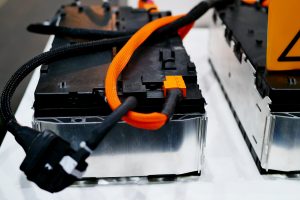
At the beginning of 2020, there were around 1.3 billion passenger cars on roads worldwide, including about 5 million electric vehicles. By 2030, electric vehicle production is expected to rise to 245 million, more than thirty times current levels. Electric vehicles consume at least four times the amount of metals compared to petrol or diesel vehicles. An electric vehicle with a 75KWh battery uses 56kg of nickel, 12kg of manganese, 7kg of cobalt and 85kg of copper for electrical wiring.
This is why the European Union has committed to building a complete supply chain for critical raw materials. “More than 200 companies, governments and research organisations have formed an alliance to secure the raw materials the EU needs for the clean energy transition and digital transformation,” says, for example, Minerals in Depth.1)mineralsindepth.org
“Huge new battery factories are being built – like Tesla owner Elon Musk’s famous Gigafactory – and they too will be hungry for cobalt,” the BBC wrote in a 2018 report, quoting Bram Murton, a geologist at the UK’s National Oceanography Centre. He estimated that if all cars on Europe’s roads were electric by 2040 and used the same kind of batteries as the Tesla Model 3, the demand for cobalt would be 28 times higher than the amount currently produced.2)Shukman, David (2018): The secret on the ocean floor. https://www.bbc.co.uk/news/resources/idt-sh/deep_sea_mining
Rare metals are also needed for “clean energy”
The expansion of wind and solar energy is also proceeding at a rapid pace, and each wind turbine and solar panel requires large quantities of such metals. For example, it takes 4.7 tonnes of copper and 2 tonnes of rare earths to build a single 3 MW wind turbine.3)National Wind Watch (30. August 2013), Metals and minerals in wind turbines: https://www.wind-watch.org/documents/metals-and-minerals-in-wind-turbines/
Added to this is the boom in consumer electronics and telecommunications, whose devices also require a large number of rare metals. The copper content of a smartphone, for example, is 0.02 kg, that of a laptop around 0.25 kg. Today, these devices have a lifespan of only a few years, and we are still far from a recycling economy that would make the metals usable again, which means that these resources are “lost” for the time being.
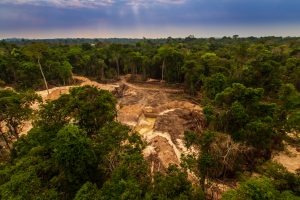
Deep-sea mining is increasingly seen as the only solution to the looming shortage of raw materials. Leading companies in this field, such as Deep Green Metals, argue that deep-sea mining is much more ecological than mining on land. Land-based mining is associated with increased deforestation, toxic tailings, habitat destruction with dire impacts on freshwater ecosystems, indigenous peoples and, in the case of cobalt, child labour.4)Deep Green Metals (2021), Open Letter to Brands on the Benefits of Seafloor Nodules: https://deep.green/open-letter-to-brands-calling-for-a-ban-on-seafloor-minerals/ But is deep-sea mining really less damaging to the environment?
The deep sea—a sensitive and largely unexplored ecosystem
Three main sources of raw materials are found at sea depths of 3 to 5 km:
- sulfides at black smokers (copper, gold, silver)
- submarine mountains (up to several kilometres high): manganese-rich, 5-10 cm thick crusts with a high cobalt content
- manganese nodules (approx. 1-20 cm in size). Manganese nodules of about 10 cm in diameter are 3-4 million years old from the centre, whereas their surface is about 10,000 years old. These nodules grow only a few centimetres in a million years, and only 3% of the nodules are nickel, copper, cobalt and lithium.
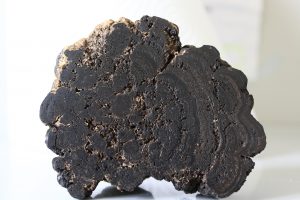 All three sources are at the same time hotspots of biodiversity and very sensitive habitats that have evolved over millions of years. For example, the manganese nodules are home to immobile faunas (such as stalked sponges), which in turn harbour special organisms, such as small corals, brittle stars and small crustaceans. These special organisms, which are only found here, are dependent on the stalked sponges as a habitat and to filter food from the water column. It is believed that 90% of the deep-sea inhabitants live in the top 10 centimetres of the seabed. Researchers are constantly finding new species and believe that millions of creatures have yet to be discovered by humans. In fact, the surface of Mars has been more thoroughly explored than the bottom of the deep sea.
All three sources are at the same time hotspots of biodiversity and very sensitive habitats that have evolved over millions of years. For example, the manganese nodules are home to immobile faunas (such as stalked sponges), which in turn harbour special organisms, such as small corals, brittle stars and small crustaceans. These special organisms, which are only found here, are dependent on the stalked sponges as a habitat and to filter food from the water column. It is believed that 90% of the deep-sea inhabitants live in the top 10 centimetres of the seabed. Researchers are constantly finding new species and believe that millions of creatures have yet to be discovered by humans. In fact, the surface of Mars has been more thoroughly explored than the bottom of the deep sea.
Effects of deep-sea mining
To recover the manganese deposits, huge deep-sea robots weighing several tonnes are to plough up and remove the seabed. Along with the coveted nodules, the top 10 centimetres of the seabed – the habitat of most species – will be completely removed. An additional problem is the sediment clouds created by this mining process. The removed bottom material is transported to the sea surface through pipes and, after the nodules have been extracted, returned to the sea. As a result, vast quantities of very fine clay particles enter the water column and settle only very slowly. These massive sediment clouds can cause the filter organs of the small organisms, which filter their nutrients directly from the seawater, to become stuck and clogged.
As early as 1989, German ocean researchers launched a unique long-term experiment (JPI Oceanproject Mining Impact) in the Peru Basin. To explore the impact of potential deep-sea mining on seabed biodiversity, the scientists ploughed up the seabed in an area of about 11 square kilometres. They drew 78 tracks (1-2 km long and 2-3 m wide) with a ploughshare, thus furrowing 20 % of the seabed. The top 10 centimetres, where the manganese nodules are contained, were completely ploughed up, including the organisms that live there.
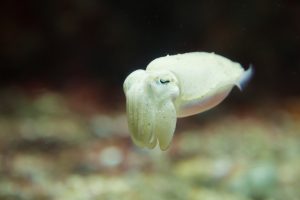
In 2015, German deep-sea biologists returned to this area with the research vessel “Sonne” [“sun”]. It turned out that even after 26 years, the plough tracks from back then were still clearly visible. The animal and plant life had not recovered even after many decades because the flow of food at this depth is so low. Because it is dark and very cold in the deep sea, the metabolism of the organisms is much slower: a mini-octopus, for example, remains there for 2 years and incubates its eggs. What can be regenerated on land with reforestation in 10-20 years takes several hundred, perhaps thousands of years in the deep sea.
As mentioned, in the deep-sea plains most of the fauna is settled on the manganese nodules or needs them as substrate. Since the nodules were ploughed under in the Peru Basin in the experiment mentioned above, there was no longer a habitat for this fauna. And because the nodules only grow back on the sediment surface after a few million years, the damage is permanent. But the fauna living in the softer sediment around it was also permanently disturbed, because the ploughing up brought to the surface layers of sediment that are more compact and harder, making life more difficult for these organisms.
A heat map showed that in the adjacent undisturbed area there was still good biochemical activity of the microorganisms. In the ploughed terrain, however, the microorganisms were reduced to one tenth. This means that entire faunal classes down to microorganisms and bacteria are damaged, resulting in the large-scale, sustainable removal of complete biotope ecosystems. The researchers’ conclusion: life in the plough tracks had demonstrably not recovered over the course of 26 years.5)Haeckel, Matthias (2019): Tiefseebergbau und seine Auswirkungen. Video by Science Notes: https://www.youtube.com/watch?v=ZElJqoWfVZY
Deep-sea mining—current state of affairs
Deep-sea mining is planned on a large scale, especially in the Clarion-Clipperton Zone (CCZ). This is located in the Central Pacific Ocean between Hawaii and the Mexican coast and covers an area of 4.5 million square kilometres, which is roughly equivalent to the land area of the 27 member states of the European Union. According to current knowledge, this zone is the largest deposit on the planet in terms of metal deposits. There are said to be billions of manganese nodules 4,500 metres below the sea surface.6)Deutsche Welle, Rohstoffe fürs E-Auto vom Meeresboden: https://www.dw.com/de/rohstoffe-f%C3%BCrs-e-auto-vom-meeresboden/a-53604025 Since this zone lies outside the territorial waters of nation states, it is administered by the International Seabed Authority (ISA), which was founded in 1994. The ISA, composed of 167 member states (all parties to the UN Convention on the Law of the Sea) and the European Union (as of March 2020), is mandated to organise, regulate and control all mineral-related activities in the international seabed area for the benefit of all humankind7)International Seabed Authority: https://isa.org.jm/index.php/about-isa
To date, there are only exploration licences for the Clarion-Clipperton Zone. In 2019, the ISA has issued 15 exploration licences mainly to China, Russia, Korea, Belgium and Germany, with Germany already investing100 million Euros in deep-sea mining and securing an area of 75,000 square kilometres west of Mexico.
In total, the ISA has already awarded 30 deep-sea mining exploration licences for millions of square kilometres by 2020, which lie in the Indian, Atlantic and Pacific Oceans. Now investors such as the Canadian company Deep Green Metals are pushing to conclude negotiations soon.8)Deutsche Stiftung Meeresschutz (May 30th, 2020): Wissenschaftler schlagen Alarm. https://www.stiftung-meeresschutz.org/themen/tiefseebergbau/wissenschaftler-schlagen– See also: What is Deep Sea Mining? A web series. Episode 1: Tools for Ocean Literacy alarm / https://youtu.be/gXj4EUoaV7c Each contractor will be able to mine 200 to 300 square kilometres per year (roughly the area of Munich). As described, the sediment clouds around these mining areas will also cause destruction, amounting to between 600 and 800 square kilometres per mining area. On land, only forestry mining in the Amazon exploits such large areas.
The consequences of this large-scale destruction in the deep sea cannot be foreseen. For example, larvae in the deep sea of the entire Pacific are related to each other via reproduction. However, no one knows how this gene exchange works and over what temporal and spatial scales this happens. If a large area in the middle of the Pacific is destroyed, this could jeopardise this gene exchange.
Meanwhile, dozens of licences have been granted by Pacific island states to corporations planning deep-sea mining projects. For example, commercial deep-sea mining is to be carried out for the first time in the territorial waters of Papua New Guinea, in the middle of the Coral Triangle. Deep Sea Mining Finance Limited (DSMF) is about to start the world’s first commercial mining of massive sulphide deposits on the seabed there with the “Solwara 1” project.
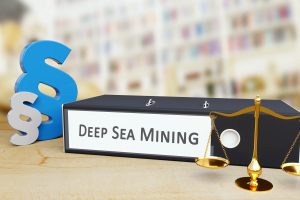
The ISA is currently still in the process of drawing up a set of regulations, the so-called “Mining Code”, for the mining of the raw materials. A current 6-week expedition of the JPI Oceans project “MiningImpact” with the aim of conducting an independent scientific environmental study in parallel with the testing of the prototype manganese nodule collector vehicle of the Belgian company Global Sea Mineral Resources (GSR) is to provide further recommendations for improved environmental standards and guidelines for the writing of this “Mining Code”.9)Informationsdienst Wissenschaft (6. April 2021), Erforschung der Umweltfolgen von Manganknollen-Abbau in der Tiefsee: https://idw-online.de/de/news766289
Moratorium and Deep Sea Mining Summit in August 2021
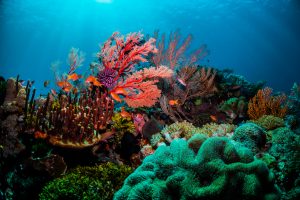
In view of the enormous risks to the ocean ecosystem and thus to the entire planet, numerous environmental organisations, the European Parliament, some Pacific island states and the fishing industry are calling for a global moratorium on deep-sea mining until the ecological, social and economic impacts have been thoroughly analysed and until it has been proven that deep-sea mining can be carried out in a way that ensures the effective protection of the marine environment and prevents the loss of biodiversity. In addition, all alternative options to reduce the consumption of raw materials through a circular economy should be exhausted beforehand.
For the first time, a coalition of companies also came forward with this demand in March 2021. Starting with the BMW Group, Samsung SDI, Google and Volvo Group also support this initiative. WWF10)World Wildlife Fund (31. März 2021), Wirtschaft unterstützt erstmals Forderung nach Moratorium für Tiefseebergbau: https://www.wwf.de/2021/maerz/unternehmen-gegen-tiefseebergbau See also: Savethehighseas.org (Juni 2020), Deep Sea Mining, Fact Sheet 3: http://www.savethehighseas.org/wp-content/uploads/2020/06/DSCC_FactSheet3_DSM_moratorium_4pp_web.pdf is calling on other companies to also commit to not extract any mineral resources from the deep sea for the time being, to refrain from using these deep-sea resources in their supply chains and to not finance deep-sea mining activities.
The moratorium and its growing support by various actors are urgently needed, and is a clear signal to companies and investors not to fall into the fallacy that deep-sea mining is inevitable and an “ecological” investment area. Also in view of the 9th International Deep Sea Mining Summit, which is to take place in London in August 2021, the efforts for the implementation of the moratorium must be even more broadly supported in order to prevent the granting of excavation licences. This is because this International Forum is expected to bring together a wide range of solution providers, deep-sea miners, members of the scientific community and people from related industries who want to learn more about the opportunities in this emerging market.11)https://www.deepsea-mining-summit.com/
The United Nations has proclaimed the years 2021 to 2030 as the Decade of Ocean Science in order to assert the central role of the ocean and achieve the “2030 Agenda for Sustainable Development Goals, including in particular Goal 14 ‘Life under Water’ – Conserve and sustainably use the oceans, seas and marine resources.12)Kooperation International (8. Januar 2021), UN-Dekade der Ozeanforschung für Nachhaltige Entwicklung (2021-2030) hat begonnen: https://www.kooperation-international.de/aktuelles/nachrichten/detail/info/un-dekade-der-ozeanforschung-fuer-nachhaltige-entwicklung-2021-2030-hat-begonnen/” In view of this, it seems downright cynical and renders the aspirations of the Decade of Ocean Exploration implausible if its own International Seabed Authority (ISA) were to issue licences for deep-sea mining during the same period, especially as this authority would also be tasked with ensuring the effective protection of the marine environment from harmful impacts that may arise from activities on the seabed.
In principle, the global community must ask itself whether wind energy and electric cars are really purposeful in effectively and sustainably protecting our Earth. Blinded by the lure of new market opportunities that are to be made palatable to us under the guise of ecology and environmental protection, few actors are asking the really important questions. Is digitisation really as “green” as it claims to be? Can we really afford to intervene even more in the sensitive, unique, precious, life-giving ecosystem of the sea, about which we still know far too little, but on which all life on this planet depends; and which is already under massive pressure from overfishing, (plastic) pollution, poisoning of all kinds, radiation from radioactive substances and other stresses? When will we learn that every cause has an effect and that we must no longer harm the planet with our actions? Deep-sea mining will not replace mining on land and will not compensate for the damage it causes. On the contrary, there is every indication that we are digging ourselves an even deeper pit!
Further Information:
- Deep Sea Conservation Coalition, diverse Fact Sheets zum Tiefseebergbau: http://www.savethehighseas.org/resources/publications/deep-sea-mining-factsheets/
- Scientific American (31. August 2020), Deep-Sea Mining: How to Balance Need for Metals with Ecological Impacts: https://www.scientificamerican.com/article/deep-sea-mining-how-to-balance-need-for-metals-with-ecological-impacts1/
- World Wildlife Fund (10. Februar 2021), WWF report: deep seabed mining is an avoidable environmental disaster: https://www.wwf.eu/?2111841/WWF-report-deep-seabed-mining-is-an-avoidable-environmental-disaster
- World Wildlife Fund (Januar 2021), Hintergrunddokument Tiefseebergbau: Rohstoffabbau in der Tiefsee bedroht hochsensible Lebensräume: https://www.wwf.de/fileadmin/fm-wwf/Publikationen-PDF/WWF-Hintergrunddokument-2021-Tiefseebergbau.pdf
- https://wwf.panda.org/discover/our_focus/oceans_practice/no_deep_seabed_mining
- https://miningimpact.geomar.de/
References
| ↑1 | mineralsindepth.org |
|---|---|
| ↑2 | Shukman, David (2018): The secret on the ocean floor. https://www.bbc.co.uk/news/resources/idt-sh/deep_sea_mining |
| ↑3 | National Wind Watch (30. August 2013), Metals and minerals in wind turbines: https://www.wind-watch.org/documents/metals-and-minerals-in-wind-turbines/ |
| ↑4 | Deep Green Metals (2021), Open Letter to Brands on the Benefits of Seafloor Nodules: https://deep.green/open-letter-to-brands-calling-for-a-ban-on-seafloor-minerals/ |
| ↑5 | Haeckel, Matthias (2019): Tiefseebergbau und seine Auswirkungen. Video by Science Notes: https://www.youtube.com/watch?v=ZElJqoWfVZY |
| ↑6 | Deutsche Welle, Rohstoffe fürs E-Auto vom Meeresboden: https://www.dw.com/de/rohstoffe-f%C3%BCrs-e-auto-vom-meeresboden/a-53604025 |
| ↑7 | International Seabed Authority: https://isa.org.jm/index.php/about-isa |
| ↑8 | Deutsche Stiftung Meeresschutz (May 30th, 2020): Wissenschaftler schlagen Alarm. https://www.stiftung-meeresschutz.org/themen/tiefseebergbau/wissenschaftler-schlagen– See also: What is Deep Sea Mining? A web series. Episode 1: Tools for Ocean Literacy alarm / https://youtu.be/gXj4EUoaV7c |
| ↑9 | Informationsdienst Wissenschaft (6. April 2021), Erforschung der Umweltfolgen von Manganknollen-Abbau in der Tiefsee: https://idw-online.de/de/news766289 |
| ↑10 | World Wildlife Fund (31. März 2021), Wirtschaft unterstützt erstmals Forderung nach Moratorium für Tiefseebergbau: https://www.wwf.de/2021/maerz/unternehmen-gegen-tiefseebergbau See also: Savethehighseas.org (Juni 2020), Deep Sea Mining, Fact Sheet 3: http://www.savethehighseas.org/wp-content/uploads/2020/06/DSCC_FactSheet3_DSM_moratorium_4pp_web.pdf |
| ↑11 | https://www.deepsea-mining-summit.com/ |
| ↑12 | Kooperation International (8. Januar 2021), UN-Dekade der Ozeanforschung für Nachhaltige Entwicklung (2021-2030) hat begonnen: https://www.kooperation-international.de/aktuelles/nachrichten/detail/info/un-dekade-der-ozeanforschung-fuer-nachhaltige-entwicklung-2021-2030-hat-begonnen/ |










